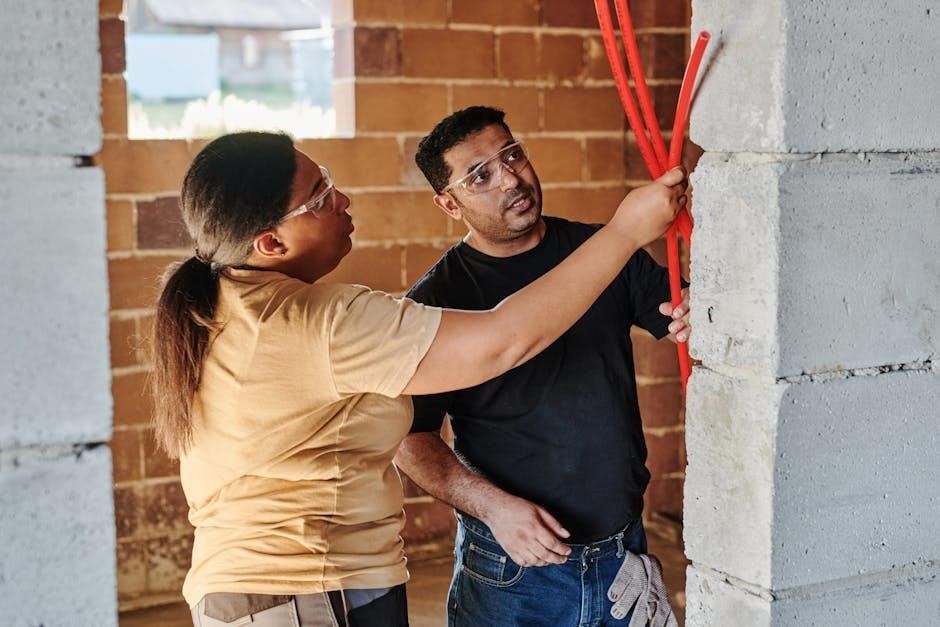Welcome to the Airvo 2 Instruction Manual. This guide provides essential information for safe and effective operation. It covers setup, features, maintenance, and troubleshooting.
1.1 Purpose of the Manual
The purpose of this manual is to provide healthcare professionals with comprehensive guidance on the safe and effective use of the Airvo 2 humidifier. It details setup, operation, and maintenance procedures to ensure optimal performance. The manual also serves as a reference for troubleshooting common issues and understanding technical specifications. By following the instructions, users can maximize the device’s functionality while minimizing risks. This guide is essential for anyone involved in the setup, operation, or maintenance of the Airvo 2 system in clinical or home care settings.
1.2 Target Audience
This manual is primarily intended for healthcare professionals, including respiratory therapists, nurses, and clinicians, who are responsible for setting up and operating the Airvo 2. It is also useful for clinical engineering personnel involved in servicing and maintaining the device. Additionally, home care providers and patients using the Airvo 2 for personal therapy will benefit from the guide. The manual assumes a basic understanding of respiratory care principles and is designed to ensure safe and effective use of the Airvo 2 humidifier in both clinical and home environments.
1.3 Scope of the Manual
This manual provides comprehensive guidance on the Airvo 2 humidifier, covering its setup, operation, maintenance, and troubleshooting. It includes detailed technical specifications, flow rate settings, and compatible patient interfaces. The manual also addresses safety precautions, disinfection procedures, and replacement of parts. Intended for healthcare professionals and home users, it ensures safe and effective use of the device. The content is organized to assist clinicians, respiratory therapists, and patients in understanding and optimizing the Airvo 2 for high-flow nasal therapy and respiratory care;

Technical Specifications of the Airvo 2
The Airvo 2 offers adjustable flow rates, precise humidity control, and compatibility with various patient interfaces. It integrates a flow generator and humidifier for high-flow nasal therapy.
2.1 Overview of the Airvo 2 Humidifier
The Airvo 2 Humidifier is a high-flow nasal therapy device designed for spontaneously breathing patients. It integrates a flow generator and humidifier, delivering warmed, humidified respiratory gases through nasal prongs. The system supports adjustable flow rates and temperatures, ensuring personalized therapy for both pediatric and adult patients. Its compact design and user-friendly interface make it ideal for clinical and home settings. The Airvo 2 is known for its efficiency, safety, and ease of use, providing optimal comfort and therapeutic benefits for patients requiring respiratory support.
2.2 Flow Rate and Humidity Settings
The Airvo 2 offers adjustable flow rates from 5 to 60 liters per minute, ensuring precise control for individual patient needs. Humidity levels can also be customized, providing optimal comfort and therapeutic effectiveness. The device features a user-friendly interface with clear controls, allowing healthcare professionals to easily adjust settings. Real-time monitoring ensures accurate delivery of prescribed flow and humidity, supporting patient comfort and clinical outcomes. These adjustable settings make the Airvo 2 versatile for various respiratory care applications, from pediatric to adult patients.
2.3 Compatible Patient Interfaces
The Airvo 2 is designed to work seamlessly with a range of patient interfaces, including Optiflow nasal interfaces, masks, and chambers. These interfaces ensure effective delivery of warmed, humidified gases for respiratory comfort. The Optiflow nasal interfaces are particularly popular for high flow therapy, offering minimal discomfort and easy use. Additionally, the device supports various adapters and connectors, allowing customization to meet specific patient needs. Compatibility with these interfaces enhances the versatility of the Airvo 2, making it suitable for diverse clinical applications and patient populations.

Setting Up the Airvo 2
Setting up the Airvo 2 involves unpacking, inspecting, and connecting the device. Ensure all components are included and undamaged. Follow the manual for proper assembly and connection.
3.1 Unpacking and Inspection
When unpacking the Airvo 2, carefully inspect all components for damage or defects. Ensure the humidifier, chamber, tubing, and patient interfaces are included. Verify the integrity of the power cord and adapters. Check for any visible signs of damage, such as dents, cracks, or bent parts. If any items are missing or damaged, contact your supplier immediately. Refer to the manual for a detailed list of included components. Proper inspection ensures safe and effective operation of the device.
3.2 Connecting the Device
Connect the Airvo 2 components securely. Attach the chamber to the main unit, ensuring it clicks into place. Next, connect the tubing to the chamber’s outlet and the patient interface. Make sure all connections are tight to prevent leaks. Plug the power cord into a compatible outlet and ensure the adapter is properly secured; Turn on the device and allow it to initialize. Check for any air leaks by gently squeezing the tubing. Proper connections are critical for optimal performance and patient safety.
3.3 Powering On the Airvo 2
To power on the Airvo 2, ensure all connections are secure. Plug the power cord into a compatible electrical outlet and confirm the adapter is properly seated. Press the power button located on the front panel. The device will initialize, and the display will illuminate. Allow a few moments for the system to perform its self-test. Once complete, the Airvo 2 will enter standby mode, indicated by a steady light. Ensure no error messages or alarms are present before proceeding to operation. Always refer to the manual for specific startup procedures and safety guidelines.

Operating the Airvo 2
The Airvo 2 delivers high flow warmed and humidified respiratory gases. Adjust flow rates and temperature settings as prescribed. Ensure patient interfaces are securely connected for optimal therapy.
4.1 Adjusting Flow and Temperature Settings
To adjust the Airvo 2 flow and temperature settings, use the Up and Down buttons on the control panel. Select the desired flow rate (up to 60 L/min) and temperature (31-37°C). Ensure the settings align with the patient’s prescribed therapy. The device automatically adjusts humidity based on the selected flow and temperature. Monitor the display for real-time feedback. Adjustments should be made by healthcare professionals only, following clinical guidelines. Regularly check and maintain optimal settings to ensure effective therapy and patient comfort.
4.2 Using the Nebulizer Adapter
The Airvo 2 Nebulizer Adapter allows for simultaneous nebulization and humidification. Attach the adapter to the chamber, ensuring a secure connection. Fill the nebulizer with prescribed medication and connect it to the adapter. The device will deliver aerosolized medication alongside heated, humidified gas. Ensure compatibility with the patient’s therapy requirements. Monitor the flow rate and adjust as needed. Regularly inspect the adapter for blockages and clean according to the manual. Always follow clinical guidelines and manufacturer recommendations for safe and effective use.
4.3 Monitoring Patient Settings
Regularly monitor the Airvo 2 settings to ensure optimal therapy delivery. Check the temperature, flow rate, and humidity levels to confirm they align with the patient’s needs. Observe the control panel for any alarms or alerts, addressing issues promptly. Ensure the patient’s comfort and clinical response are maintained. Adjust settings as prescribed by healthcare professionals, adhering to clinical guidelines. Use the manual to guide adjustments and troubleshooting. Document any changes for continuity of care. Proper monitoring ensures effective and safe therapy, enhancing patient outcomes and device performance. Always follow the manufacturer’s recommendations for patient setting adjustments.

Maintenance and Cleaning
Regular cleaning and maintenance are crucial for the Airvo 2’s functionality and hygiene. Follow the manual’s guidelines for daily routines, disinfection, and part replacements.
5.1 Daily Cleaning Procedures
Daily cleaning is essential to maintain the Airvo 2’s performance and hygiene. Start by turning off and unplugging the device. Disassemble the chamber, tubing, and other components. Wash these parts with mild detergent and warm water, ensuring no residues remain. Rinse thoroughly and allow to air dry. Regularly inspect for visible debris or mold. Follow the manual’s disinfection guidelines to prevent bacterial growth; Proper cleaning ensures optimal functionality, patient safety, and longevity of the device. Always refer to the manual for specific instructions tailored to your Airvo 2 model.
5.2 Disinfection Guidelines
Disinfecting the Airvo 2 is crucial for maintaining hygiene and patient safety. Use a solution of 70% isopropyl alcohol and 30% water. Soak all reusable components for 10 minutes, ensuring thorough coverage. Avoid using harsh chemicals that may damage the device. After soaking, rinse components with clean water and allow them to air dry. Regular disinfection prevents bacterial growth and ensures optimal performance. Follow the recommended frequency for disinfection, especially in high-use environments. Always refer to the manual for specific instructions on disinfecting different parts of the Airvo 2. Proper disinfection maintains device integrity and patient health.
5.3 Replacing Parts and Accessories
Regular replacement of parts and accessories ensures optimal performance and patient safety. Replace the chamber, tubing, and other worn components every 6–12 months or as indicated in the manual. Use only Fisher & Paykel-approved parts to maintain device integrity. Refer to the manual for specific instructions on replacing each accessory. Discard damaged or expired items promptly. Proper replacement prevents device malfunction and ensures accurate flow delivery. Always consult the manual or contact technical support if unsure about compatibility or installation procedures. Timely replacement enhances device longevity and reliability.

Troubleshooting Common Issues
This section addresses common issues like error codes, flow rate problems, and humidity level inconsistencies. Follow diagnostic steps and solutions to restore optimal functionality. Refer to the manual or contact technical support for assistance.
6.1 Error Codes and Solutions
The Airvo 2 displays error codes to indicate specific issues. Common codes include low water levels, high temperature, or flow rate malfunctions. Refer to the manual for code definitions.
– Code 1: Check water chamber or power supply.
– Code 2: Ensure proper air filter installation.
– Code 3: Verify temperature settings within range. Solutions involve restarting the device, checking connections, or replacing faulty parts. Contact technical support if issues persist.
6.2 Resolving Flow Rate Problems
Flow rate issues may occur due to blockages or incorrect settings. Ensure the tubing is kink-free and properly connected. Check the power source and verify the flow rate is within the recommended range (1-60 L/min). If the issue persists, clean or replace the air filter. Ensure the device is on a stable surface. If flow rate remains inconsistent, reset the device by turning it off and on. For severe problems, contact technical support or refer to the troubleshooting guide for advanced solutions. Always follow safety guidelines when addressing flow rate malfunctions.
6.3 Addressing Humidity Level Issues
Humidity issues may arise if the water chamber isn’t filled correctly or if the device isn’t properly calibrated. Ensure the water level is within the recommended range and the chamber is clean. Check for blockages in the tubing or connections, as these can disrupt humidity delivery. If the issue persists, reset the device by turning it off and on. For accurate humidity control, ensure the temperature settings align with the patient’s needs. Regularly cleaning the water chamber and ensuring proper ventilation can prevent humidity imbalances. Refer to the manual for detailed calibration steps if needed.

Safety Precautions and Warnings
Ensure proper use of the Airvo 2 to avoid injury. Follow all safety guidelines in the manual, including electrical precautions and correct operation procedures.
7.1 General Safety Guidelines
Adhere to all safety precautions to ensure safe operation of the Airvo 2. Only use approved accessories and follow the manufacturer’s instructions. Regularly inspect the device for damage. Ensure the device is placed on a stable, flat surface away from flammable materials. Avoid exposing the Airvo 2 to extreme temperatures or moisture. Never modify the device or use it for purposes other than intended. Keep children away from the device during operation. Follow proper cleaning and disinfection procedures as outlined in the manual. Always unplug the device before performing maintenance or repairs. Failure to comply may result in injury or device malfunction.
7.2 Patient Safety Considerations
Ensure patient safety by adhering to specific guidelines when using the Airvo 2. Always monitor the patient’s condition and respiratory status. Verify that the device is set up correctly and that all connections are secure. Use only the recommended nasal interfaces and ensure proper fit to avoid discomfort or air leaks. Regularly check the temperature and humidity settings to prevent overheating or over-humidification. Keep emergency oxygen equipment nearby for patients with severe respiratory conditions. Supervise pediatric or elderly patients closely during therapy. Report any adverse reactions or unexpected symptoms to healthcare providers immediately. Always follow the prescribed therapy settings and ensure the patient understands how to use the device safely.
7.3 Electrical Safety Measures
Adhere to electrical safety measures to ensure safe operation of the Airvo 2. Use the device only with the provided power cord and plug, and ensure it is connected to a grounded electrical outlet. Avoid using damaged power cords or outlets, as this may cause electrical hazards. Do not expose the device to water or moisture, as this can lead to electrical shock. Clean the device only as instructed in the manual, avoiding the use of excessive liquid. Ensure all electrical components are intact and free from damage. Regularly inspect the power cord and connectors for wear or damage. Always use genuine Fisher & Paykel parts to maintain electrical safety. If the device malfunctions, disconnect it from the power source immediately and contact technical support. Never attempt to modify or repair the device yourself, as this may result in electrical hazards or void the warranty. Ensure the device is properly grounded at all times to prevent electrical shock. Monitor the device for any signs of overheating or unusual operation and take appropriate action if necessary. Keep the device away from flammable materials and ensure proper ventilation in the room where it is used. Always follow the manufacturer’s guidelines for electrical safety to ensure the device operates safely and effectively. Regularly review the electrical safety guidelines in this manual to stay informed and maintain compliance with safety standards. By following these measures, you can help prevent electrical accidents and ensure the safe operation of the Airvo 2 for all users.

Accessories and Consumables
Explore the range of accessories and consumables designed for the Airvo 2, including chambers, tubing, and nebulizer adapters. These items are essential for optimal device performance and patient comfort. Regularly replacing consumables like filters and masks ensures hygiene and effectiveness. Always use genuine Fisher & Paykel parts to maintain warranty and safety. Refer to the manual for replacement schedules and ordering information.
8.1 Recommended Accessories
The Airvo 2 is compatible with a range of accessories to enhance functionality and patient comfort. These include Optiflow nasal prongs, tubing, and chambers designed for optimal performance. Additional accessories like the nebulizer adapter enable aerosol therapy delivery. Using genuine Fisher & Paykel parts ensures compliance with safety standards and maintains device warranty. Regularly replacing consumables such as filters and masks is crucial for hygiene and effectiveness. Refer to the manual for a full list of recommended accessories and guidelines for their use. Properly selected accessories ensure the Airvo 2 operates efficiently and provides reliable therapy for patients.
8.2 Consumable Items and Replacement Schedule
The Airvo 2 requires regular replacement of consumable items to ensure optimal performance and patient safety. Key consumables include the chamber, tubing, and filters, which should be replaced every 30 days or as specified in the manual. The nebulizer adapter and patient interfaces may need more frequent replacement, depending on usage. Always use genuine Fisher & Paykel parts to maintain warranty and safety standards. Follow the recommended replacement schedule to prevent device malfunction and ensure hygiene. Proper disposal of used consumables is essential for infection control. Refer to the manual for detailed guidelines on replacement procedures and intervals.
8.3 Ordering Spare Parts
To ensure uninterrupted operation, order genuine Fisher & Paykel spare parts through authorized distributors or the official website. Verify part numbers from the Airvo 2 manual to avoid errors. Contact customer support for assistance with orders or to locate a distributor. Avoid using non-genuine parts, as they may void the warranty or compromise safety. Keep a record of purchases for tracking and future reference. Always check for availability and lead times to plan ahead. Properly store spare parts in a clean, dry environment to maintain their quality and functionality.

Clinical Applications of the Airvo 2
The Airvo 2 is primarily used for high flow nasal therapy, providing warmed, humidified air to support respiratory comfort in both pediatric and adult patients.
9.1 High Flow Nasal Therapy
The Airvo 2 is designed to deliver high flow nasal therapy, providing warmed and humidified respiratory gases to patients. This therapy is ideal for patients requiring supplemental oxygen or humidification. The device uses Optiflow nasal interfaces, ensuring comfort and effectiveness. It supports flow rates of up to 60 L/min, making it suitable for both adult and pediatric patients. The adjustable temperature and flow settings allow customization to meet individual patient needs. High flow nasal therapy with the Airvo 2 is commonly used in respiratory care to improve patient comfort and clinical outcomes, making it a versatile tool in various clinical settings.
9.2 Use in Respiratory Care
The Airvo 2 is widely used in respiratory care to deliver high flow warmed and humidified gases, enhancing patient comfort and clinical outcomes. It is particularly effective in treating patients with chronic obstructive pulmonary disease (COPD), pneumonia, and other respiratory conditions. The device supports flow rates of up to 60 L/min, making it suitable for both adult and pediatric patients. By providing consistent humidification, it helps reduce airway resistance and improves oxygenation. This therapy is often used in hospitals, clinics, and home care settings, offering a reliable solution for patients requiring respiratory support.
9.3 Pediatric and Adult Applications
The Airvo 2 is designed for both pediatric and adult patients, offering versatile respiratory support. Its adjustable flow rates and temperature settings accommodate diverse clinical needs. In pediatric care, it is used for neonatal and infant respiratory support, while adults benefit from its high flow therapy for chronic respiratory conditions. The device is ideal for use in ICU, ward, and home care settings, ensuring consistent and reliable treatment across all age groups. Its portability and ease of use make it a preferred choice for clinicians treating patients of all ages.

Additional Resources
Access the Airvo 2 PDF manual, technical support, and online training for detailed guidance and troubleshooting. Visit the official Fisher & Paykel website for more resources.
10.1 Downloading the PDF Manual
The Airvo 2 Instruction Manual is available for download as a PDF from Fisher & Paykel’s official website or authorized distributors. This document provides detailed guidance on setup, operation, troubleshooting, and maintenance. It is specifically designed for healthcare professionals and technical personnel to ensure safe and effective use of the device. The manual includes technical specifications, clinical applications, and safety precautions. To access the PDF, visit the Fisher & Paykel Healthcare website and navigate to the Airvo 2 product page. Additionally, authorized distributors may offer direct download links for convenience. Always refer to the official sources for the most up-to-date version.
10.2 Accessing Technical Support
For assistance with the Airvo 2, contact Fisher & Paykel’s technical support team directly through their official website or regional offices. The website provides contact information, including phone numbers and email addresses, for prompt support. Additionally, authorized distributors offer technical assistance and troubleshooting guidance. Online resources, such as FAQs and user forums, are available to address common inquiries. For urgent issues, a 24/7 helpline is accessible to ensure uninterrupted support for healthcare professionals. Always refer to official channels for reliable and timely assistance with the Airvo 2 device.
10.3 Online Training and Tutorials
Fisher & Paykel offers comprehensive online training and tutorials for the Airvo 2, accessible via their official website. These resources include instructional videos, webinars, and interactive modules designed to guide healthcare professionals through device operation, maintenance, and troubleshooting; The training materials emphasize proper setup, flow rate adjustment, and patient interface compatibility. Additionally, tutorials cover advanced features like temperature control and nebulizer integration. Users can access these resources through the Fisher & Paykel website or authorized distributors. Regular updates ensure the content aligns with the latest clinical guidelines and device enhancements.
